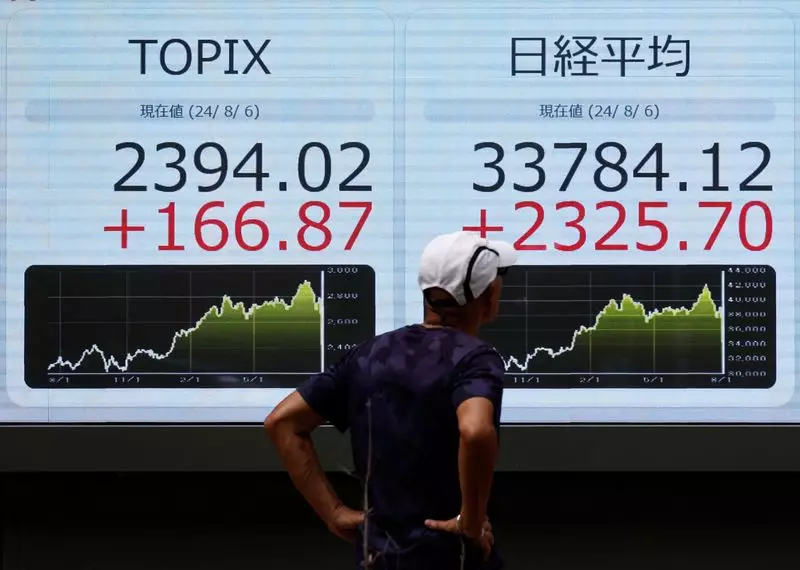In the fast-paced world of finance, market movements can often hinge on key monetary policies and economic indicators. As of mid-week, Asian stocks reached their highest levels in over two months, invigorated by the anticipation of further monetary easing in the United States and a corresponding eye on Australia’s central bank decisions. This article delves into the current dynamics prevailing in Asian markets, the implications of U.S. Federal Reserve policies, and the contextual backdrop that drives investor sentiment across the region.
As indicated by the MSCI Asia-Pacific index, stocks outside Japan rallied by approximately 0.04%, showcasing a resilience in the region. This marks the index’s most robust levels since mid-July, indicating an underlying upward trend despite the volatility that characterizes the financial markets.
Japan’s Nikkei index stood out with a striking surge of 1.69%, moving towards its highest point in nearly three weeks. Much of this enthusiasm revolves around the anticipation of a crucial speech by Kazuo Ueda, the Governor of the Bank of Japan. Investors are keenly awaiting his insights on potential shifts in monetary policy.
A key element driving this optimism is the recent tone set by the Federal Reserve. Notably, the Fed executed a substantial reduction of 50 basis points, a move that provided a safety net to risk-sensitive assets globally, including in Asia. While traditional wisdom suggests that U.S. policy usually ripples through global markets, the specific effects depend on how other countries react to these shifts, particularly in relation to their economic outlooks.
China’s financial regulators recently met to strategize responses to the country’s slowing economy, rolling out a series of initiatives aimed at revitalizing growth. Among these measures is a noteworthy reduction in mortgage rates for existing home loans, which may placate consumer anxiety and encourage spending. Such structural adjustments are anticipated to provide a necessary boost not just for the domestic market, but also for regional economic partners closely tied to China.
The central bank lowered its 14-day repo rate by 10 basis points which, at first glance, seems modest but signals a commitment to easing liquidity in the face of economic headwinds. The efficacy of these measures, however, exists in question, given the mixed responses from previous rate reductions. Investors will want to monitor subsequent data releases to gauge the extent of any real impact.
Shifting focus to the Reserve Bank of Australia (RBA), the anticipation builds as markets predict the bank will maintain its current rates during the upcoming policy meeting. Charu Chanana of Saxo suggests the RBA will hold onto a hawkish tone for the time being, aiming to stabilize inflation expectations. However, market participants are eagerly speculating on a potential shift in direction by the November meeting—conditional upon forthcoming labor market data and third-quarter Consumer Price Index (CPI) results.
The context is pivotal. Traders remain cautious but optimistic, holding their breath for any signal from the RBA that could suggest a parallel path to the Fed’s interest rate reductions.
The ripple effects of recent U.S. monetary policies are palpable throughout the financial landscape. Chicago Fed President Austan Goolsbee emphasized the cautious optimism behind the substantial rate cut, insisting that thoughtful action is necessary to achieve a “soft landing” for the U.S. economy. The overarching sentiment in markets is a delicate balance between reduced rates and the hope for sustained economic health.
Current speculation suggests that a 50 basis point cut may be on the horizon for November, though market observers express skepticism regarding the Fed’s ability to proceed without robust job data to reinforce such a move. As a result, the next non-farm payroll report looms large, with potential implications on both U.S. and Asian market projections.
In the commodities arena, oil prices saw slight upticks, maintaining a careful navigation amid demand concerns and evolving economic indicators from Europe. Brent crude futures rose, albeit modestly, suggesting an ongoing tug-of-war between supply constraints and economic apprehensions.
Meanwhile, the U.S. dollar’s position reflects this uncertainty, hovering close to one-year lows against competing currencies, further heightening interest in growth-sensitive currencies like the Australian dollar. As economic landscapes evolve, both markets and investors remain on high alert, ready to react to any further shifts in monetary strategies or economic indicators.
The current landscape reveals a complex interplay of market optimism driven by U.S. monetary policy expectations and national economic measures across Asia. Stakeholders must remain vigilant as conditions evolve, shaping investment decisions and the overall financial climate.


Leave a Reply